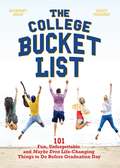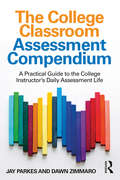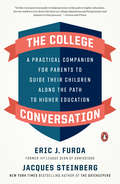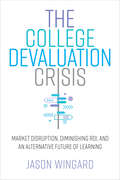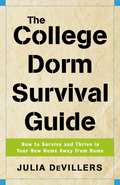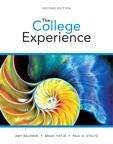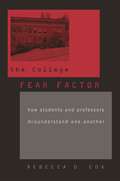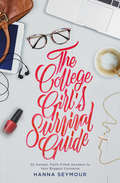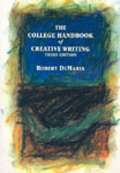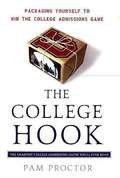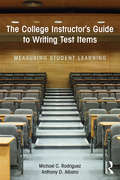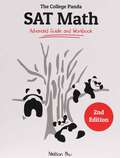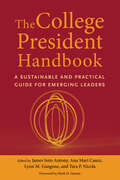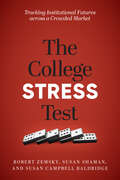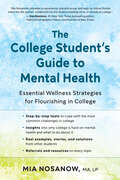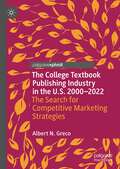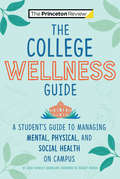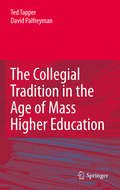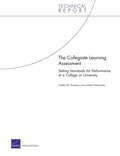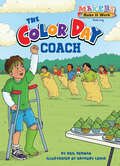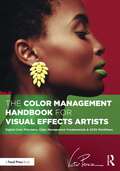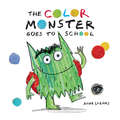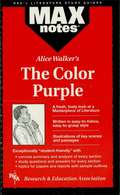- Table View
- List View
The College Bucket List: 101 Fun, Unforgettable and Maybe Even Life-Changing Things to Do Before Graduation Day
by Kourtney Jason Darcy PedersenTHE IDEAL GIFT FOR HIGH SCHOOL GRADUATES AND COLLEGE FRESHMEN, THIS BOOK IS PERFECT FOR STUDENTS LOOKING TO MAKE MEMORIES AND GRADUATE WITHOUT REGRETS! Are you ready to experience the best four years of your life? Take a shot at half of the exciting ideas in The College Bucket List and your first years of freedom will be absolutely legendary. •Go on an epic road trip • Throw an ugly sweater party • Organize a student protest • Buy your professor a drink • Find the best late-night taco truck • Audit a cool class just for fun • Kiss someone you just met • Do a summer internship
The College Classroom Assessment Compendium: A Practical Guide to the College Instructor’s Daily Assessment Life
by Jay Parkes Dawn ZimmaroThe College Classroom Assessment Compendium provides new and seasoned instructors with comprehensive strategies, perspectives, and solutions for the daily challenges and issues involved in student assessment. Composed of cross-referenced, research-based entries organized for effective and immediate access, this book provides systematic explanations of assessment policies and practices, including guidelines for classroom implementation. Situated beyond the techniques covered in most instructor training and preparation, these practical entries draw from a variety of disciplines and offer an invaluable reference for college instructors interested in developing coherent, reliable classroom assessment climates.
The College Conversation: A Practical Companion for Parents to Guide Their Children Along the Path to Higher Education
by Jacques Steinberg Eric J. FurdaFrom an Ivy League dean and a college admissions expert, a guide to help parents support their children as they navigate their way to collegeThe College Conversation is a comprehensive resource for mapping the path through the college application process that provides practical advice and reassurance to keep both anxious parents and confused children sane and grounded. Rather than adding to the existing canon of "How to Get In" college guides or rankings, Eric Furda and Jacques Steinberg provide a step-by-step approach to having the tough conversations on this topic with less stress and more success.The book is organized around key discussions and themes that trace the chronological arc of admissions and financial aid--beginning before the assembly of a list of potential colleges and continuing through the receipt of decisions--with a final section that includes advice on the first year of college. The topics include preliminary conversations about the search, and specifically how parents can think about their children's interests and what kind of college would best suit them; choosing a college (based on its curriculum, culture, and community); writing the most effective essays; assessing acceptances, including considerations of finances and aid; and making the transition from high school to college life. The College Conversation will provide parents, students, and counselors with the credible, level-headed information often missing in this process, as well as a much-needed dash of perspective borne of experience.
The College Devaluation Crisis: Market Disruption, Diminishing ROI, and an Alternative Future of Learning
by Jason WingardEmployers are stepping in to innovate new approaches to training talent that increasingly operates independently of the higher education sector. The value proposition of the college degree, long the most guaranteed route to professional preparation for work, is no longer keeping pace with rapidly evolving skill needs that derive from technological advancements impacting today's work force. If the university system does not engage in responsive restructuring, more and more workplaces will bypass them entirely and, instead, identify alternative sources of training that equip learners with competencies to directly meet dynamic needs. The College Devaluation Crisis makes the case that employers and other learning and development entities are emerging to innovate new approaches to training talent that, at times, relies on the higher education sector, but increasingly operates independently in order to satisfy talent needs more agilely and effectively. Written primarily for managers, the book focuses on case studies from leading companies, including Google, Ernst & Young, and General Assembly, to illustrate their innovative strategies for talent development across varying levels of individual education, age, and background. The book also addresses professionals on the university side, urging readers to consider the question: Will higher education pivot and adapt, or will it resist change and, therefore, be replaced?
The College Dorm Survival Guide: How to Survive and Thrive in Your New Home Away from Home
by Julia DevillersThe Ultimate Guide to Surviving and Thriving in the Dorm Dorm life offers you a great chance to meet new people and try new things. But leaving the comforts of home for the first time to enter the roommate-having, small-room-sharing, possibly-coed-bathroom-using world of the dorms can be overwhelming and intimidating. The College Dorm Survival Guideoffers expert advice and the inside scoop on: • Choosing the right residence hall for you • Getting along with your roommate (and handling conflict) • Bathroom, laundry, and dining hall survival • Dealing with stress, depression, and safety issues From avoiding the dreaded Freshman 15 to decorating your space, this informative and funny guide gives experts' advice on everything you need to know to enjoy dorm living to the fullest.
The College Experience (Second Edition)
by Amy Baldwin Paul G. Stoltz Brian TietjePart of the Experience Series for college students in a four-year program,The College Experience, 2/e incorporates the GRIT framework, supplying learners with powerful success strategies and tools for college completion and career success—get in, get through, get out, and get paid. The authors recognize that understanding what it takes to succeed in college is one thing, but having the personal GRIT to make it happen is what makes the difference. <p><p> Framed in a practical, situational manner, the book helps students navigate what to do, when do it, and where to go for support. It provides scientifically grounded yet practical tips and tools students need to grow greater GRIT, which research shows as the most powerful predictor of success in school and beyond. <p> Students 'Get in, Get through' using a firm foundation of distinctive features to stay in, and get through, college with academic, social, and transitional skills. In order to 'Get out, Get paid' it equips students with a blend of professional and GRIT-based mindset required to successfully graduate and enter a career that fulfills their educational and personal goals.
The College Fear Factor: How Students amd Professors Misunderstand One Another
by Rebecca D. CoxThey’re not the students strolling across the bucolic liberal arts campuses where their grandfathers played football. They are first-generation college students—children of immigrants and blue-collar workers—who know that their hopes for success hinge on a degree. But college is expensive, unfamiliar, and intimidating. Inexperienced students expect tough classes and demanding, remote faculty. They may not know what an assignment means, what a score indicates, or that a single grade is not a definitive measure of ability. And they certainly don’t feel entitled to be there. They do not presume success, and if they have a problem, they don’t expect to receive help or even a second chance. Rebecca D. Cox draws on five years of interviews and observations at community colleges. She shows how students and their instructors misunderstand and ultimately fail one another, despite good intentions. Most memorably, she describes how easily students can feel defeated—by their real-world responsibilities and by the demands of college—and come to conclude that they just don’t belong there after all. Eye-opening even for experienced faculty and administrators, The College Fear Factor reveals how the traditional college culture can actually pose obstacles to students’ success, and suggests strategies for effectively explaining academic expectations.
The College Fear Factor: How Students and Professors Misunderstand One Another
by Rebecca D. CoxThey’re not the students strolling across the bucolic liberal arts campuses where their grandfathers played football. They are first-generation college students—children of immigrants and blue-collar workers—who know that their hopes for success hinge on a degree. But college is expensive, unfamiliar, and intimidating. Inexperienced students expect tough classes and demanding, remote faculty. They may not know what an assignment means, what a score indicates, or that a single grade is not a definitive measure of ability. And they certainly don’t feel entitled to be there. They do not presume success, and if they have a problem, they don’t expect to receive help or even a second chance. Rebecca D. Cox draws on five years of interviews and observations at community colleges. She shows how students and their instructors misunderstand and ultimately fail one another, despite good intentions. Most memorably, she describes how easily students can feel defeated—by their real-world responsibilities and by the demands of college—and come to conclude that they just don’t belong there after all. Eye-opening even for experienced faculty and administrators, The College Fear Factor reveals how the traditional college culture can actually pose obstacles to students’ success, and suggests strategies for effectively explaining academic expectations.
The College Girl's Survival Guide: 52 Honest, Faith-Filled Answers to Your Biggest Concerns
by Hanna SeymourHanna Seymour, a mentor to thousands of young college women, provides a plan for success in college based on experience, illustrations, and biblical principles.Each year millions of young women enter the college scene and are surprised to find their glittering preconceptions shattered. College isn't exactly what they had imagined--it's a lot tougher. Social challenges, a demanding schedule, pressure to succeed, shifting family dynamics: how do girls tackle these issues, learn to thrive, and really enjoy this new phase of life? THE COLLEGE GIRL'S SURVIVAL GUIDE is packed with experienced-based advice that can help. Written by a mentor with ten years of experience helping college girls succeed, it's like having a big sister along for the journey. With proven tips, scripture, and inspiring illustrations, this book will coach, comfort, and inspire young women so that they can make the most of the college experience.Thousands of young women have asked Hanna Seymour what to do about roommate drama, boyfriend trouble, choosing a major, balancing family and school life, and so much more. She's poured her best insights into this book--answering the top 52 questions she has received--so that readers everywhere will be armed with the knowledge and inspiration to make college the most epic, enriching time it can be.
The College Handbook of Creative Writing
by Robert DemariaThe textbook is designed for all creative writing courses. It covers fiction, poetry, and drama, and explores such across-the-genres subjects as theme, setting, characters, plot, point of view, tone, style, description, dialogue, thoughts, time, images, and sounds.
The College Hook: Packaging Yourself to Win the College Admissions Game
by Pam ProctorA comprehensive guide to the powerful packaging tool called the "Hook"--a special talent or achievement that leaps off the page of a college application and catches the eye of admissions officers. Competition for entry to the nation's top colleges is at an all-time high--and intensifying every year. Now nationally recognized college consultant and writer Pam Proctor reveals the "packaging" secrets that can help any student maximize the odds of admission to the college of his or her choice. Using real life anecdotes and examples from winning applications, Proctor provides students with a step-by-step program that will enable them to determine and develop their unique "Hook," and then package and market themselves at every stage of the admissions process.
The College Instructor's Guide to Writing Test Items: Measuring Student Learning
by Michael Rodriguez Anthony AlbanoThe College Instructor’s Guide to Writing Test Items: Measuring Student Learning addresses the need for direct and clear guidance on item writing for assessing broad ranges of content in many fields. By focusing on multiple-choice response items, this book provides college instructors the tools to understand, develop, and use assessment activities in classrooms in a way that consistently supports learning. Including dozens of example items and additional resources to support the item development process, this volume is unique in its practical-focus, and is essential reading for instructors and soon-to-be educators, professional development specialists, and higher education researchers. As teaching, assessment, and learning are inherently intertwined, The College Instructor’s Guide to Writing Test Items both facilitates the development of instructors’ own practice and improves the learning outcomes and success of students.
The College Panda's SAT Math: Advanced Guide and Workbook
by Nielson PhuA second edition fully updated for the current SAT (2020 and beyond) <p><p>This book brings together everything you need to know for the SAT math section. Unlike most other test prep books, this one is truly geared towards the student aiming for the perfect score. It leaves no stones unturned. <p><p> Inside, You'll Find: <p> Clear explanations of the tested math concepts, from the simplest to the most obscure <p>Hundreds of examples to illustrate all the question types and the different ways they can show up <p>Over 500 practice questions and explanations to help you master each topic <p>The most common mistakes students make (so you don’t) <p><p>This is the most thorough SAT prep out there. For more sample chapters and information, check out <p>http://thecollegepanda.com/books <p><p> Changes from the 1st edition include: <p> Additional chapter on minimum and maximum word problems <p>Ratio questions <p>Function transformations <p>Boxplots <p>Many additional practice questions spread throughout <p>Many revisions to fine-tune the review material to the current SAT <p>Many formatting and typo fixes
The College President Handbook: A Sustainable and Practical Guide for Emerging Leaders
by James Soto Antony, Ana Mari Cauce, Lynn M. Gangone, and Tara P. Nicola&“This volume combines specific recommendations, observations, and takeaways filled with candor, humor, and uplifting stories for one of education&’s most challenging roles.&”—FROM THE FOREWORDAn indispensable manual for the most demanding position in higher education, The College President Handbook supports campus leaders in becoming powerful and effective stewards of their institutions.This comprehensive guidebook offers clear counsel in the form of candid essays by highly regarded current and former college and university presidents from across the nation. It pairs their expert appraisals with research and data to examine the critical issues that define the role today.The book's contributors acknowledge the broad skill set that presidents, and their executive teams, must cultivate in order to achieve success. Beginning with a macro view, the contributors address the universal questions of vision that each higher education leader must consider critically and understand strategically: Why be a president? How should campus leadership engage with our board of trustees? What tone should our actions communicate to stakeholders?The book's chapters offer concrete tactical advice in a range of key leadership areas and emphasize essential career skills such as managing financial resources and strategic planning. The contributors speak to student-facing concerns as well as institutional interests, and discuss personal issues specific to the office, such as weathering controversy, attaining work–life balance, and planning for post-presidential life.Drawing on the unique expertise of peers and predecessors, this work will prove to be a core resource for anyone who is or aspires to become a president or chancellor in higher education.
The College Stress Test: Tracking Institutional Futures across a Crowded Market
by Robert Zemsky Susan Shaman Susan Campbell BaldridgeProvides an insightful analysis of the market stresses that threaten the viability of some of America's colleges and universities while delivering a powerful predictive tool to measure an institution's risk of closure.In The College Stress Test, Robert Zemsky, Susan Shaman, and Susan Campbell Baldridge present readers with a full, frank, and informed discussion about college and university closures. Drawing on the massive institutional data set available from IPEDS (the Integrated Postsecondary Education Data System), they build a stress test for estimating the market viability of more than 2,800 undergraduate institutions. They examine four key variables—new student enrollments, net cash price, student retention, and major external funding—to gauge whether an institution is potentially at risk of considering closure or merging with another school. They also assess student body demographics to see which students are commonly served by institutions experiencing market stress. The book's appendix includes a powerful do-it-yourself tool that institutions can apply, using their own IPEDS data, to understand their level of risk.The book's underlying statistical analysis makes clear that closings will not be nearly as prevalent as many prognosticators are predicting and will in fact impact relatively few students. The authors argue that just 10 percent or fewer of the nation's colleges and universities face substantial market risk, while 60 percent face little or no market risk. The remaining 30 percent of institutions, the authors find, are bound to struggle. To thrive, the book advises, these schools will need to reconsider the curricula they deliver, the prices they charge, and their willingness to experiment with new modes of instruction. The College Stress Test provides an urgently needed road map at a moment when the higher education terrain is shifting. Those interested in and responsible for the fate of these institutions will find in this book a clearly defined set of risk indicators, a methodology for monitoring progress over time, and an evidence-based understanding of where they reside in the landscape of institutional risk.
The College Student’s Guide to Mental Health: Essential Wellness Strategies for Flourishing in College
by Mia NosanowEasy, accessible guidance for addressing an essential element to college success: mental health While being in college can be an exciting time, it can also be a period of uncertainty, anxiety, loneliness, and even depression. The College Student’s Guide to Mental Health is for any college student who wants to understand and maintain mental and emotional health. Mia Nosanow, a licensed psychologist and college therapist, has drawn upon her more than twenty years of direct experience counseling a diverse college student body to write a comprehensive mental and emotional health manual designed specifically for college students. Presented in clear, practical language and organized in short chapters, this book breaks down common problems and provides actionable strategies for addressing them. Whether students want to understand challenging emotions, transform negative thoughts, improve relationships, or explore the connection between time management and mental health, these topics and more can be found in this one book — a valuable tool for college students as well as the families and professionals who support them.
The College Textbook Publishing Industry in the U.S. 2000-2022: The Search for Competitive Marketing Strategies (Marketing and Communication in Higher Education)
by Albert N. GrecoThis book explores the college textbook publishing industry, from its inception in medieval universities, through the late 20th century, to the present day which has led to an existential crisis for some publishers. The various sections in this book offers a comprehensive analysis of the substantive developments, problems, and concerns about a myriad of major issues that confronted the higher education textbook sector after 2000. Chapters incorporate highly reliable textbook statistical sources as well as a review of some marketing theories utilized by these publishers (e.g., understanding the threat of substitute products; the sale of used and rental texts; the sale of new digital textbooks).
The College Wellness Guide: A Student's Guide to Managing Mental, Physical, and Social Health on Campus (College Admissions Guides)
by The Princeton Review Casey Rowley BarnesonA brand new guide that helps overwhelmed students manage their mental, physical, and social health, and reach and maintain a healthy balance in their college lives.Every year, nearly two million students arrive at college campuses, ready to embark on the best four years of their lives. Yet the reality is that the current cohort of students is one of the most stressed, anxious, and depressed ever. These stressors have real effects on students' grades, social life, and physical health. And the stakes are high! Students with the right community and support services have better outcomes, from increased chances of on-time graduation, to greater ability to take on head-start opportunities (like internships) that have deep impact on post-college life.The Princeton Review is proud to introduce The Campus Wellness Guide, an innovative new book that provides a mix of information, resources, and self-assessment activities to help students reach and maintain their overall health. The book includes: • Information on how to assess your college fit academically and socio-emotionally • Self-assessment activities that students can use to ID their specific stressors and ways to alleviate those issues • Sections on physical, mental, and social wellness, each with data-backed insights and research to help define the issues and strategies for handling • Proactive activities for student use, with reflection prompts to help develop roadmaps toward a healthier status quo • Wellness highlights, e.g., information on colleges with exceptional track records in specific wellness issues • Resources for national and college-specific help
The College on the Hill: New History of the Ontario Agricultural College, 1874 to 1999
by Alexander Ross Terry CrowleyHow has the Ontario Agricultural College contributed to Canadian education? What role has the college played in the development of agriculture since it was founded in 1874? This history of Canada’s oldest agricultural college revolves around these two questions. It shows that the college’s mandate has changed in its attempt to serve both education and agriculture. The Ontario Agricultural College was established to enshrine science in farming, but it also became the testing and extension arm of the provincial ministry of agriculture. Direct government control for ninety years provided financial resources not enjoyed by other post-secondary schools, but the results sometimes proved of greater benefit to agriculture than to education or science. Swept into the University of Guelph when it was created in 1964, the college rethought its role. It emerged as a centre for advanced scientific inquiry, for global agricultural programs, and for understanding rural societies. The controversies surrounding these changes and the evolving nature of agriculture and science are brought out fully in this account of the past century and a quarter.
The Collegial Tradition in the Age of Mass Higher Education
by David Palfreyman Ted TapperThis book will examine the relationship between collegiality and the collegial tradition in the context of the development of mass higher education. The collegial tradition in higher education has been shaped above all by the collegiate universities. In all its various forms (as commensality, as a mode of governance, and as a critical force in shaping the process of teaching, learning and research) the collegial tradition has found sustenance in many sectors of higher education. It may well be that the tradition as expressed in these forms now has more strength and depth in the non-collegiate than in the collegiate universities. This work will give a fuller picture of the present-day character of British (especially English) higher education. Although this is a book that will rely particularly upon the Oxford experience of collegiality, there will be extensive comparative and international reference to the idea of collegiality, the various challenges to it that have emerged within different national systems, and the contrasting patterns of adjustment to those challenges.
The Collegiate Learning Assessment
by Chaitra M. Hardison Anna-Marie VilamovskaThe Collegiate Learning Assessment (CLA) is a measure of how much students' critical thinking improves after attending college or university. This report illustrates how institutions can set their own standards on the CLA using a method that is appropriate for the CLA's unique characteristics.
The Color Day Coach: Baking (Makers Make It Work)
by Gail HermanTying into the popular Makers Movement, Makers Make it Work is a series of fun easy-to-read stories that focus on problem-solving and hands-on action. With bright, eye-catching art and explanatory sidebars with additional information on the topic, these books show kids how to use their hands, their heads, their creativity, and their problem-solving skills to overcome every challenge facing them. Jake is the best athlete in his class. Everyone wants him on their team for Color Day! But then Jake trips and gets badly hurt. How can he help his team win with a broken leg? With the Makers Make It Work series, any kid can be a Maker! Each book also includes an activity for young makers to try themselves. (Topic: Baking).
The Color Management Handbook for Visual Effects Artists: Digital Color Principles, Color Management Fundamentals & ACES Workflows
by Victor PerezVictor Perez brings together the research and expertise of world-leading color scientists to create a comprehensive guide for visual effects (VFX) artists in color management. This book explores the latest standards of high dynamic range (HDR) and Academy Color Encoding System (ACES) workflows, in an easily digestible and widely applicable resource. Its purpose is to make artists confident and familiar with Color Management and its science, to improve the quality of visual effects worldwide. Without assuming any previous knowledge, this self-contained book builds the reader’s understanding from the ground up, exploring all the elements of the color workflow at a scientific level. It covers how to set up a consistent pipeline in relation to other departments, inside and outside visual effects, from camera to screen, so everybody is aligned to the same standards, preserving color qualities and consistency while maintaining the artistic intent end to end. It also delves into all the integral concepts for color management, ranging from color theory to digital image fundamentals, and much more. This book is an invaluable resource for VFX students and professionals who want to be well informed about the latest HDR and ACES pipelines, as well as those at every level of production wishing to gain a deeper understanding of managing color in visual effects projects.
The Color Monster Goes to School (The Color Monster)
by Anna LlenasThis fun and inviting back-to-school story stars the lovable, mischievous hero from the international bestseller The Color Monster.The Color Monster feels a little nervous. Today is his first day at school . . . and he doesn't even have a clue what school is! But, guided by his young friend, the Color Monster has lots of new adventures and makes new friends -- and looks forward to tomorrow.With bold colors and child-friendly art for young readers -- and an adorable, shaggy rainbow critter as the star -- The Color Monster Goes to School is a showstopping introduction to the joy and wonder of first school days.
The Color Purple (MAXNotes Literature Guides)
by Christopher HubertREA's MAXnotes for Alice Walker's The Color Purple MAXnotes offer a fresh look at masterpieces of literature, presented in a lively and interesting fashion. Written by literary experts who currently teach the subject, MAXnotes will enhance your understanding and enjoyment of the work. MAXnotes are designed to stimulate independent thought about the literary work by raising various issues and thought-provoking ideas and questions. MAXnotes cover the essentials of what one should know about each work, including an overall summary, character lists, an explanation and discussion of the plot, the work's historical context, illustrations to convey the mood of the work, and a biography of the author. Each chapter is individually summarized and analyzed, and has study questions and answers.
